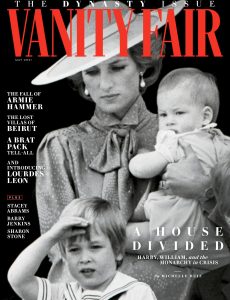
Vanity Fair USA – May 2021
English | 109 pages | pdf | 59.01 MB
Welcome at Vanity Fair USA Magazine May 2021 issue
following genealogical lines to settle an inheritance—tracing old families and creating new ones. He wrote orphan characters precisely to play out those fictional fantasies. Parentless children could embody a kind of magical social mobility that most Englishmen and women didn’t possess at the time. You didn’t know where a foundling came from, to whom he or she might
claim relation. Poor Oliver Twist, in his namesake novel (of which the young Queen Victoria was a fan; she recommended it to her prime minister), is adopted by a gentleman; poor Esther Summerson in Bleak House turns out to be the daughter of an aristocrat. The state of the family—its ability to endure, to escape the poorhouse intact, to survive misplaced wills and internecine court battles,and most critically to preserve wealth and status for future generations—was, in those 19th-century novels, a metaphor for the state of the nation, and the empire. What is Great Expectations if not an investigation into the wealth that flowed to London from the British colonies, and the grave discomfort around certain of those origin stories, all starting with a scared, young, parentless Pip?
Of course, these aren’t Victorian times, and we know the fate of the empire. Sometimes people ask me why Vanity Fair still covers the British royal family, an institution that time has wrought mostly symbolic, retrograde at best. But symbolic power still carries weight in this world. From The Crown to the blockbuster Oprah interview, the House of Windsor has proven rich territory for provoking conversation on issues ranging from soft power to racism and decolonization to the eternal allure of Hollywood.
Happy and unhappy alike, the Windsors are a deliciously contemporary lot, no more so than at this moment, when the family is better understood as a metaphor not for a nation but for a corporation: beleaguered by complaints of a toxic workplace and seeking to onboard a diversity czar. Meanwhile, its far-flung prince adds 21st-century titles like “chief impact officer” to his raft of hereditary distinctions. In America, capitalism is king, and the Sussexes are brand royalty.
In her cover story, Michelle Ruiz examines the modern royal family as Firm, following the breadcrumbs strewn by Princess Diana when she broke from the palace decades ago—the mouse that roared, as former V.F. editor Tina Brown so memorably called her in these pages.
This July, a statue of Diana will be unveiled in Kensington Palace’s Sunken Garden, and as Michelle writes, “the monarchy’s saving grace may rely on a reunion”—that of her two sons,
bridging what’s now a literal and metaphorical continental divide. It struck me, watching Harry speak of his late mother to Oprah, that he is now the age she was when she died, which only adds to the poignancy of his choices.
But when it comes to familial sagas, we at V.F. are quite democratic in our tastes. All dynasties are up for study, all the knives are out. In this issue, we follow the dark, twisted turns of the House of Hammer, whose scion, would-be Hollywood leading man Armie, fell precipitously from grace this winter. The Victorians could not have imagined a more deranged inheritance plot than the one recounted in Julie Miller’s story, in which one Hammer descendant, Armie’s aunt Casey, shores up as a kitchen designer at a
San Diego Home Depot with $100 in her savings account; as she tells Julie, if her brother would just give her one of the paintings bequeathed to him, it would set her up for life. We check in on the Kardashian-Jenner beauty empire as their 14-year Keeping Up With the Kardashians reign comes to a close. In France we visit the House of Chanel and the partnering ateliers whose
intricate craftwork gives depth and beauty to the label’s annual Métiers d’art show. Vanities features a biblical opener with Madonna’s child, Lourdes Leon. Andrew McCarthy gives us an insider’s view of the Brat Pack—friends are the family you choose, or who pop culture chooses for you. We catch up with Barry Jenkins, whose work demonstrates a different aspect of inheritance—the artistic freedom that comes from shaking off the baggage of the past. And in Beirut, through the elegiac eye of photographer Dia Mrad, we pay homage to the architectural grandeur of palatial villas wrecked in the August blast, as some residents tackle the work of preserving Beirut’s heritage amid the effort to rebuild. It’s an impulse any matriarch or patriarch would understand, the desire to pass along its treasures to the next generation, to find hope amid the ruins.
Download from: